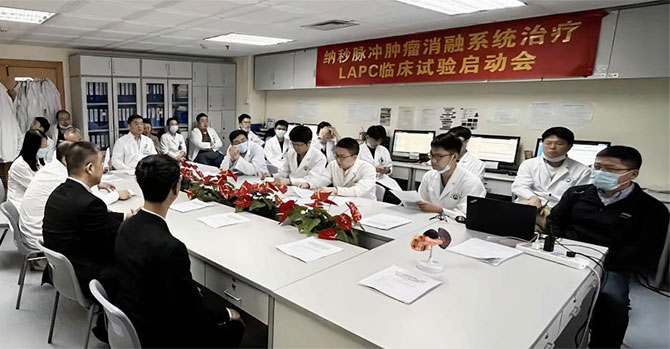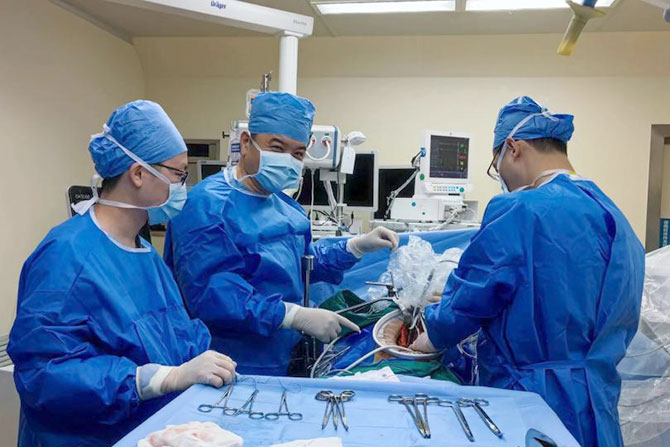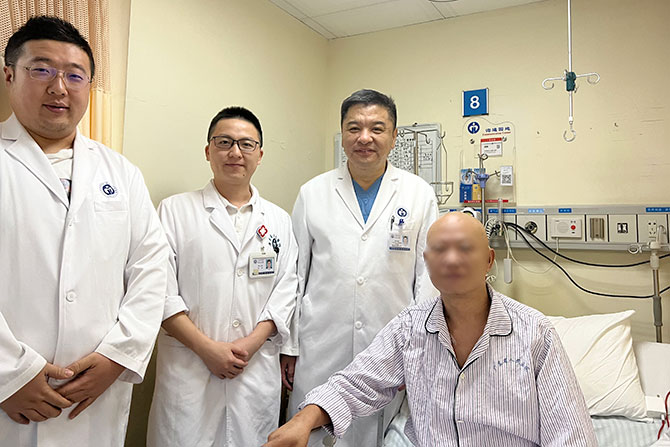

On August 9, the MDT team led by Prof. Chen Rufu from the Pancreas Center, Guangdong Provincial People’s Hospital demonstrated the power of medical innovation once again. They successfully performed nanosecond pulse precise ablation for a locally advanced pancreatic cancer sufferer who had lost access to surgery by applying a new “nanosecond knife” technology, namely the nanosecond pulse tumor ablation system. This marked the first “nanosecond knife” operation for pancreatic cancer in China, providing a new therapy for locally advanced pancreatic cancer sufferers.

A national multicenter RCT study on the nanosecond pulse tumor ablation system for pancreatic cancer treatment was launched by Prof. Chen Rufu’s team.
This is a specific “scalpel”. It is learned that the principle of the nanosecond pulse tumor ablation system is to release nanosecond high-voltage pulses through an ablation probe to penetrate cell membranes, creating nanoscale permanent perforations on tumor cells, thereby disrupting the intracellular balance and ultimately leading to tumor apoptosis. This process results in the replacement of tumor cells by regenerated healthy cells. As the latest minimally invasive tumor ablation technology in China, the greatest advantage of the “nanosecond knife” is its tissue and organ specific ablation without generating thermal energy during the ablation process. The generated pulse high-voltage current acts only on tumor cells within the probe’s treatment area. Arteries, veins (including portal veins), intrahepatic and extrahepatic bile ducts, pancreatic ducts, nerves, and other structures within the tumor treatment area are fully preserved without being ablated by the “nanosecond knife” due to their low cell membrane composition and high level of connective tissues or collagen. This characteristic of “selective ablation” ensures there is no “accidental injury” during “nanosecond knife” treatment, making it particularly suitable for malignant pancreatic tumors adjacent to important blood vessels, bile ducts, and pancreatic ducts. Since there is no thermal effect, it protects blood vessels, bile ducts, and pancreatic ducts around and even inside a tumor, significantly reducing complications and enabling the safe and effective ablation of pancreatic or hilar tumors.
The precise insertion of the “nanosecond knife” probe is the key to the success of the operation. It requires the focus to be fully included in the current network and the surgeon to grasp the anatomical position of the sufferer’s tumor, so that the electric field fully covers the tumor while avoiding damage to normal tissues such as surrounding intestines precisely. The first “nanosecond knife” operation in China was performed by Prof. Chen Rufu with the support of the MDT team composed of experts from anesthesia, radiology, ultrasound, and other departments. Before the operation, Prof. Chen Rufu’s team held MDT case discussions and formulated a detailed local ablation therapeutic scheme for this pancreatic cancer sufferer. The team not only planned the treatment steps in detail but also conducted an in-depth risk control assessment on potential anesthetic, intraoperative, and postoperative complications. During the operation, the team precisely delimited the tumor using contrast-enhanced ultrasound technology and carried out a precise probe placement planning guided by the ablation system. Under the guidance of ultrasound, the team succeeded in conducting precise puncture and probe placement steps. Upon starting the “nanosecond knife”, the high-voltage pulse it generated penetrated the focus instantaneously, achieving precise ablation for pancreatic cancer. After the operation, under the guidance of the management philosophy of Enhanced Recovery After Surgery (ERAS) at the Pancreas Center, the sufferer began to take a liquid diet and move off the bed on the first day, and the gastric tube was removed successfully. The sufferer did not experience any complications such as pancreatic fistula, hemorrhage, or infection throughout the recovery process, and was discharged on the seventh day after the operation.

The nanosecond pulse ablation for pancreatic cancer was performed by Prof. Chen Rufu.
As the leading unit of the national multicenter RCT study on the nanosecond pulse tumor ablation system for pancreatic cancer treatment, the Pancreas Center at Guangdong Provincial People’s Hospital will expand the research and application of nanosecond pulse electric fields as an innovative technology. The center will continue to deepen the exploration, practice, optimization and promotion of multidisciplinary diagnostic and therapeutic models for pancreatic cancer to protect the health of pancreatic cancer sufferers, extend their lives, improve their quality of life, and meet the individualized therapeutic needs of different sufferers. This is one of the epitomes of technological innovation achievements of medicine-engineering integration emerging at Guangdong Provincial People’s Hospital in the national technological innovation cause. In the meanwhile, it contributes to reducing costs and improving efficiency in the medical field, promoting the high-quality development of the medical industry. As a globally leading new-tech therapy based on nanosecond pulse electric fields put into practice, it provides an accessible and better choice for domestic and overseas pancreatic cancer sufferers, and will benefit worldwide pancreatic cancer sufferers in the long run.

The sufferer who received nanosecond pulse ablation for pancreatic cancer was discharged on the seventh days after the operation.
Pancreas Center
Updated: August 25, 2023